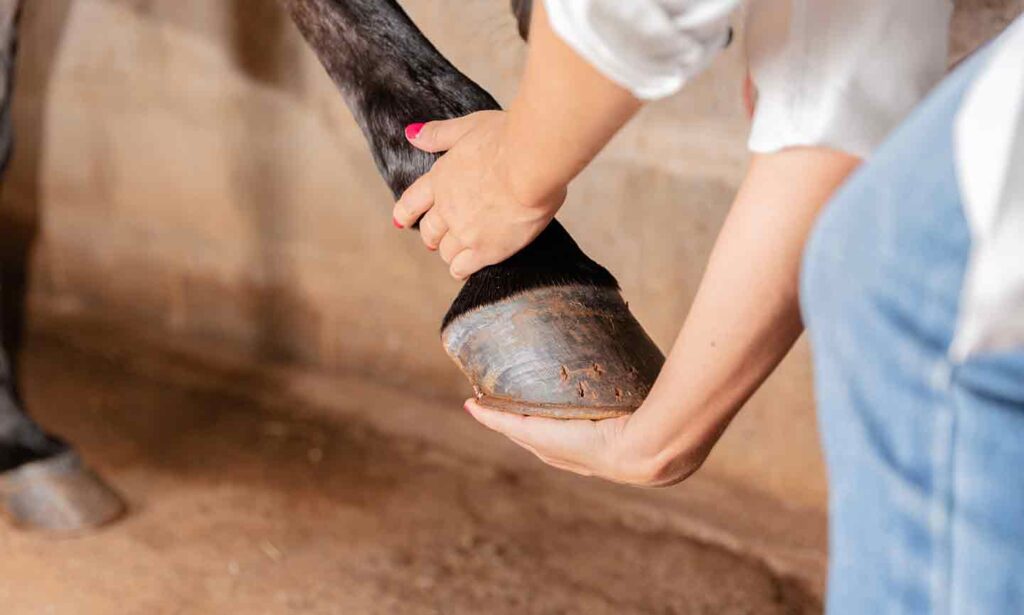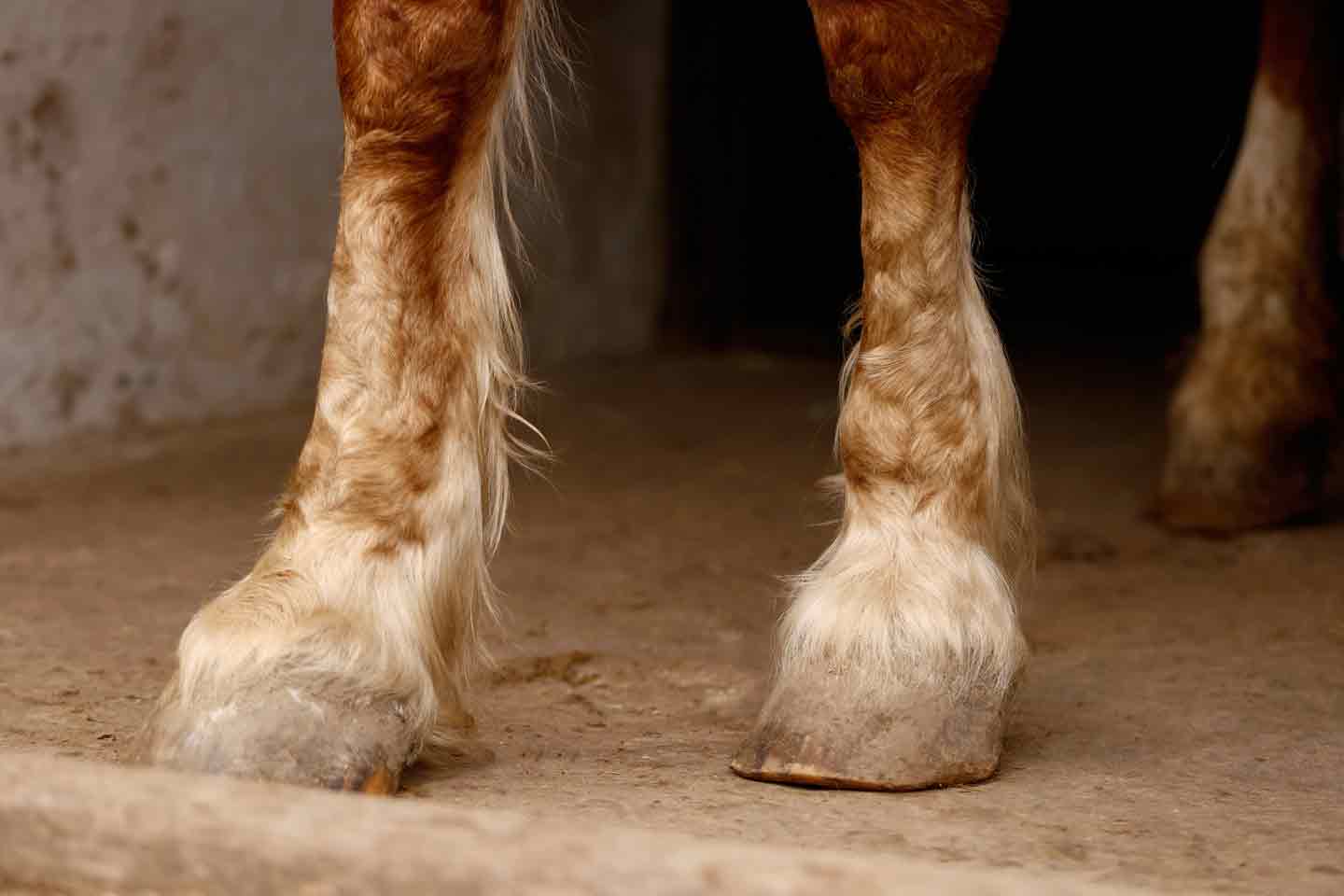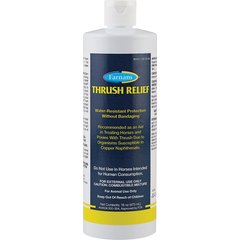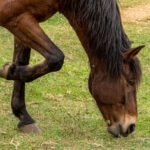Horses’ Hooves: How To Care for Your Horse’s Feet

Photo by Brastock Images/iStock / Getty Images Plus
Horse Hoof Anatomy
A horse’s hoof, or outer hoof capsule, can be split into seven distinct structures:
1. Hoof Wall
The hoof wall is made of a protein called keratin, the same one found in your own nails. This rigid structure made up of tough yet flexible horn has three layers that separate and protect the hoof’s internal structures from the outside world. The hoof wall bears most of the horse’s weight.
2. Coronary Band
The equine equivalent of your nail cuticle, the coronary band—also called the coronet—unites the hoof wall with the leg at the level of the pastern (the area between the ankle and the foot). Hoof growth starts at the coronary band.
3. Sole
The sole is the wide, slightly concave underside of the horse’s foot. Just like the hoof wall, it’s primarily made up of keratin, and its main job is to protect the inner structures of the foot as well as bear some of the horse’s weight.
4. Frog
The frog is a V-shaped, rubbery structure with a deep cleft in the middle called the central sulcus. Even though it’s also made of keratin, the frog is much more supple and pliable than the hoof wall and the sole. It’s also a sensitive structure. The frog acts as a shock absorber and helps with blood circulation.
5. Bars
Each hoof has two bars, one on either side of the frog. The bars are extensions of the hoof wall that turn inward at the heels. They support the heels and give strength and rigidity to the entire hoof capsule. Bars are made of a tough form of keratin.
6. Heel Bulbs
Just like your own heels, the horse’s heel bulbs are rounded and a little squishy. Horses have two heel bulbs per hoof. Both bars and the frog are connected to the heel bulbs, which provide support and shock absorption to the entire hoof.
7. White Line
The white line unites the hoof wall with the sole at a visible junction all around the underside of the hoof, from one heel bulb to the other. It acts as a protective barrier from outside contaminants.

Liudmila Chernetska/iStock / Getty Images Plus
Common Health Issues That Affect Horse Hooves
It may look tough and rigid, but the equine hoof actually is a living part of your horse’s anatomy that’s very much influenced by its environment. Hoof health is a crucial part of overall horse health.
Many hoof problems occur because of unhygienic living conditions, such as manure- or urine-soaked bedding in stalls, deep mud in pastures, and lack of regular hoof care. These situations can compromise the integrity of the hoof capsule, allowing debris to get inside and cause infections. Common hoof issues include:
Abscesses
Hoof abscesses are essentially large pimples. Imagine having a pocket of pus under your toenail, and what that would feel like when you walk. Pretty painful, right? It’s the same for your horse. Horses with hoof abscesses can look very lame until the abscess pops and drains. “Abscesses are definitely the most common cause of non-traumatic, hoof-related lameness I see,” says Jeremy Frederick, DVM, DACVIM, owner of Advanced Equine of the Hudson Valley, an ambulatory veterinary practice based in Wappingers Falls, New York.
Thrush
If you’ve ever picked up a horse’s hoof and been greeted with the pungent smell of a cheesy, black discharge, you’ve encountered thrush. Thrush is a bacterial infection that often starts by the frog and can also spread into the bars, sole, and heel bulbs, softening and weakening all of these vital structures.
White Line Disease
Also called seedy toe, white line disease occurs when the white line crumbles and separates due to damage. Since the white line’s job is to provide a clean junction between the outer hoof wall and the inner laminae (connective tissue), white line disease allows debris and bacteria to penetrate inside the hoof, leading to an infection that eats away at the hoof.
Hoof Cracks
Hooves split and crack when they are weak, brittle, or too dry. Overgrown or unbalanced hooves with poor conformation are also more likely to crack, so it’s important to stay on the regular trimming schedule recommended by your farrier. Much like a broken fingernail, hoof cracks can be painful depending on their location and size.
Dr. Frederick notes that hoof cracks, thrush, and white line disease are common hoof health problems in horses, so it’s important to address any hoof health issue right away.
Caring for Your Horse’s Hooves
Your horse needs a healthy diet to maintain healthy hooves. Make sure you’re feeding a balanced diet with adequate protein and biotin (vitamin B7), another nutrient essential for hoof health. If you need to add a hoof supplement to your horse’s diet, look for one that specifically contains keratin, biotin, and the key amino acids lysine and methionine.
Next up is hygiene. Cleanliness is key to keeping horse hooves healthy. Clean your horse’s stall at least daily, removing manure piles and urine-soaked bedding. Try to also limit mud exposure.
When it comes to daily hoof care, Dr. Frederick recommends cleaning your horses’ hooves daily and checking for any issues like cracks, loose nails in horseshoes (if they are shod), and stones wedged in the foot. An experienced farrier should also tend to the hooves every four to eight weeks, depending on the horse.
“A regular farrier schedule helps keep the hooves in good shape and address any issues in a timely manner,” says Dr. Frederick. Good, consistent hoof care can help prevent unbalanced, overgrown, or cracked hooves that open the door—or rather, the wall—to abscesses and other issues.
When issues do arise, over-the-counter treatments for mild cases of thrush, soft soles, and hoof brittleness are often effective, while more severe infections or functional abnormalities may require medication or corrective shoeing.
Recommended Products
FAQs About Horses’ Hooves
Can horses feel pain in their hooves?
Horses cannot feel pain in the horn that makes up the outer hoof wall and sole. However, the coronary band and the frog are both sensitive structures. A good comparison is your own finger—the nail itself doesn’t feel pain, but the cuticle and sensitive skin underneath do.
Do horse hooves grow back?
Yes, horses’ hooves are continuously growing. That’s why horses need to have their hooves trimmed every four to eight weeks, on average. It can take up to one year for a horse to grow a whole new hoof.
What do healthy hooves look like?
Healthy horse hooves have a smooth wall with no cracks or stress rings. The shape should look balanced and symmetrical. When you pick up the foot, the heel bulbs and frog should be firm, elastic, and wide, with no signs of thrush.
What causes lameness in horse hooves?
Abscesses are the most common cause of non-traumatic, hoof-related lameness, according to Dr. Frederick. Other common causes include sole bruises, white line disease, hoof cracks, and severe thrush.
What do horse’s feet look like at birth?
Foals come into the world with eponychium, also known as “foal slippers.” Foal slippers are soft, rubbery tentacles that cover the entire hoof wall to protect the mare’s birth canal from damage during labor. They wear off on their own, typically 48–72 hours after birth.
Expert input provided by Jeremy Frederick, DVM, DACVIM, owner of Advanced Equine of the Hudson Valley, an ambulatory veterinary practice in Wappingers Falls, New York.
This content was medically reviewed by Chewy vets.






